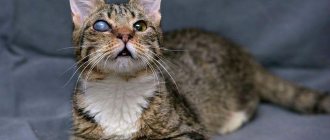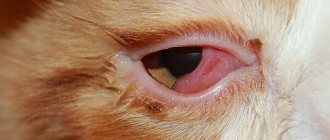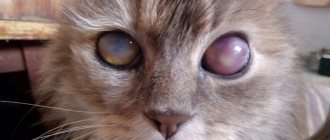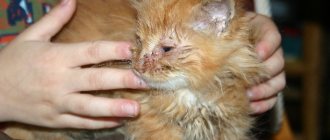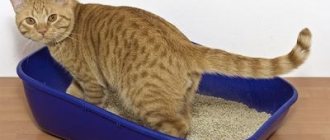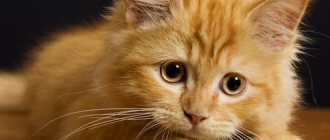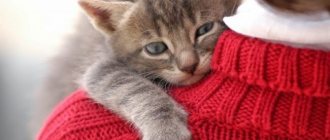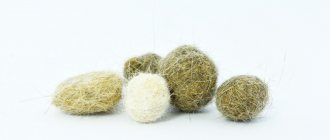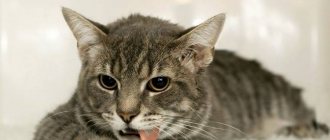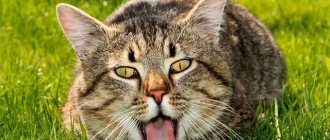The translucent film on the eyes of cats is called the third eyelid. This anatomical feature of the feline family performs important functions.
Let's find out which state of the nictitating membrane corresponds to the norm, and what is considered a pathology. We will also analyze situations in which urgent consultation with a specialist is necessary.
What to pay attention to
The formation of the film is preceded by the appearance of signs that cannot be ignored.
Tearing, white veil
Increased lacrimation can develop from infections, after injuries, or from a foreign object.
A white veil on the organ of vision appears due to weight loss, dehydration, and oncological processes. This is the third eyelid, which droops with adenoma, exophthalmos, enophthalmos .
Signs of pathology
When a white veil covers the floor of the eye, they speak of prolapse of the third eyelid. In a normal state, its movement is invisible to prying eyes. The eyelid cleans the surface of the apple and produces a third of the tear fluid.
When the gland protrudes, the following symptoms are observed:
formation of a reddish clot in the inner corner of the eye;- profuse lacrimation;
- redness of the edge of the apple;
- development of conjunctivitis.
If the condition is advanced, pus is released from the corners of the eyes, the mucous membrane swells, the animal squints, and the eyelids become swollen.
Reasons for appearance
All cats have a third eyelid, which usually remains invisible while the pet is awake. Therefore, its appearance in everyday life causes concern and often requires a visit to the veterinary clinic. When this membrane becomes visible, this indicates that it is not sufficiently or excessively moistened, the eyes are not completely cleared of dust that enters them, and the functionality of the film is impaired.
© shutterstock
There are two degrees of third eyelid prolapse:
- Protrusion;
- Prolapse.
White film growth
The third eyelid in a healthy cat is visible only when blinking, in a state of sleep.
Importance for a cat
The formation protects the cornea from dust, debris, plant thorns, etc., evenly distributes the secretion of the lacrimal gland, and protects the surface of the eye from drying out.
Reasons for sinking
An increase in film size can be associated with both external and internal factors.
There are several reasons for the development of a pathological condition:
- bacterial, viral, fungal infections;
- failure of internal organs;
- exhaustion, dehydration;
hormonal imbalance;- entry of foreign bodies;
- oncology;
- weakening of the ligaments and muscles of the eye;
- helminthiasis;
- injuries;
- allergic conjunctivitis;
- atrophy of the eyeball.
British and Persian cats are more susceptible to the development of vision pathologies due to the structural features of the skull. Regardless of other reasons, genetic predisposition is a fundamental factor in the occurrence of the disease.
Signs of adenoma
This is a benign formation. It is characterized by the appearance of a small tumor that prevents the eyes from closing completely.
Symptoms:
increased body temperature;- purulent discharge from the eyes;
- photophobia;
- neoplasms in the corners of the eyes;
- loss of appetite;
- irritability.
The animal also continuously washes itself, squints, and blinks.
Associated symptoms
If the cause of the adenoma is systemic diseases, the following signs of ill health are observed: vomiting, diarrhea, weakness, decreased activity, weight loss, deterioration in coat quality.
Symptoms of cloudy eyes in cats
Contact your veterinarian immediately if you notice any of the following symptoms:
- Rub your eyes
- Excess tear production
- Photosensitivity
- Signs of pain
- Squinting and rapid blinking
- One eye appears larger than the other
- Confusion or disorientation
- Heat
- Sneezing
© shutterstock
First aid
Self-medication in this case is strictly prohibited. Medicines are used only after consultation with a veterinarian. If you delay in going to the clinic, your pet’s condition will quickly deteriorate.
As soon as the owner notices that his pet has a white film on the organ of vision, and an urgent visit to the veterinarian is impossible, the animal is treated at home.
Wiping the eyelids
Take a clean cotton cloth, moisten it with warm filtered water, and carefully remove all discharge from the eyes from the outer corner to the inner one.
Moisturizing the eyes
If the eye is swollen, carefully spread the eyelids and drip saline solution. If the film falls out, periodically moisten the eye with saline solution and apply a sterile bandage.
Help with bleeding
If bleeding occurs, apply a sterile bandage or gauze folded in several layers to the eye (the material should not stick). When soiled, the bandage is changed, but at least once a day.
Examination by a veterinarian
At the clinic, the doctor conducts a full examination of the pet. An ophthalmoscope is used to examine the condition of the fundus.
If there are no injuries, clinical tests are prescribed.
When to contact a veterinarian
In general, the appearance of “films” on the eyes is, in any case, a bad sign and requires immediate veterinary consultation. But sometimes it is necessary to contact a specialist as urgently as possible:
- In case of a rise in general body temperature.
- If the animal behaves strangely, nervously and inappropriately.
- In case of partial or complete refusal of food by the cat.
Immediate veterinary attention is needed when a cat constantly rubs its eyes with its paw, meows and “cries” in pain. Often this is how glaucoma manifests itself, fraught with complete blindness of the pet.
A thorn in ophthalmic diseases
A white spot on the eye can appear in cats with other pathologies. All of them are characterized by a severe course and threaten the pet with disability:
- glaucoma is the most severe disease in domestic cats in terms of course and complexity of treatment;
erosion of the cornea of the eye develops due to mechanical injuries, burns, viral and bacterial diseases;- infectious processes caused by bacteria, viruses, fungi cause clouding of the cornea.
There are a number of diseases that affect the eyeball, which leads to the development of leukoma.
Recovery
Recovery and prognosis will depend on the severity of the condition and the effectiveness of treatment. Always follow your veterinarian's instructions carefully after treatment or after surgery. It is essential that you take antibiotics for the entire recommended treatment period, even if the condition begins to improve. Failure to do so may result in relapse of the aggressive disease or loss of vision.
Corneal ulcers and keratitis typically begin to heal within three to five days after treatment. Some ulcers caused by infection take longer to heal. Your veterinarian will advise you on your cat's signs.
For cataracts and glaucoma, your veterinarian may schedule follow-up visits as needed to monitor the condition. If cloudy under eyes do not improve or seem to get worse despite treatment, contact your veterinarian immediately.
Treatment
Therapy is prescribed depending on the diagnosis. Surgical and conservative treatment methods are used.
A small tumor is removed surgically without affecting the membrane itself. A large tumor is excised along with the film, and the animal is at risk of blindness.
Injuries are treated conservatively if they are shallow. Such wounds in cats heal quickly.
The injured nictitating membrane is sutured, then antibiotics are prescribed.
For inflammation due to bacterial infection, broad-spectrum antibiotics are prescribed in the form of drops and ointments.
For fungal diseases, fungicidal ointments are used.
Vitamins, minerals, nutrients, and immunomodulators are prescribed as additional treatment.
Preventive measures
To protect the tailed creature and minimize the occurrence of problems with the visual apparatus, you should do the following:
- plan a cat’s diet - it must be balanced and consist of quality products;
- do not forget about additional vitamins in the cat’s menu;
- periodically rinse your cat's eyes with Furacilin (1 tablet per 100 g of water);
- use potassium permanganate for preventive purposes;
- regularly examine the eyes of the mustachioed creature and monitor changes in its behavior;
- do not forget to free your pet from roommates - worms, fleas, etc.
- Take your pet to the veterinary clinic for examinations at least once a year.
If you notice slight redness of the mucous membrane and tearing, use Tricilin powder on the affected areas.
Prevention
Each pet needs to be provided with proper care: a balanced diet, regular hygiene procedures. Timely vaccination is important to keep your pet healthy.
It is not recommended to let your domestic cat outside; contact with stray animals is undesirable.
Timely deworming is the key to good health for your pet. The procedure is performed on kittens and adult animals.
Colors of Shorthair Scottish Fold cats (Scottish Fold Colors)
White (WHITE)
: Pure white, shiny. Eyes: deep sapphire blue or gold. A white with different eyes should have one eye sapphire blue and the other golden with equal color saturation. Nose and paw pads: pink. Black (BLACK)
: Black, coal without any rusty mixture.
Painted along the entire length. Nose is black. The pads are black or brown. The eyes are golden. Blue (BLUE)
: blue, preferably light blue, uniform.
Equally darkish is preferable to light with transitions and shades throughout the body. The nose and pads are blue. The eyes are golden. Red (RED)
: deep brilliant red, uniform, without smoke, pattern or ticking (at least see this in person, reds always have smoke, tabi, etc.).
White hairs are not allowed. Nose and pads: brick red. The eyes are golden. Cream (CREAM)
: Light shades are preferable, the color is uniform throughout the body. Nose and paw pads: pink. The eyes are golden.
